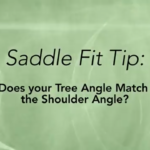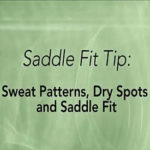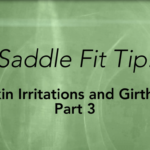Too often we hear “I bought a custom saddle!” The inference is the saddle will always fit the horse if regular re-flocking is done. Yet many riders go through ‘saddle buying hell’ trying to find a new saddle when the old saddle is now too tight at the withers, too narrow in the gullet or too long for the saddle support area. Frustration, missed lessons, physical or behavioural issues arise due to an ill-fitting saddle.
How often are saddle fit requirements for horse and rider the main consideration when buying a saddle? The 36 points of consideration for fitting the saddle to the horse are often ignored due to a tight budget, or a salesperson/saddle fitter with a (sales driven) agenda. Ask whether the saddle is disposable (cannot be adjusted in the gullet plate) or non–disposable saddle (gullet plate that can be easily adjusted). And note that many saddle manufacturers claim that this can be done – but reality is that it may work only once or twice!
With consistent and proper training your horse will change – shoulders moving farther up and back, uneven muscles and a smaller saddle support area.
An adjustable saddle has these features:
- gullet plate can be adjusted asymmetrically in width and angle to accommodate the stronger (larger) shoulder so the saddle does not slide to one side, putting excess pressure on the vertebrae
- adjustable V billet system that allows billets to be moved forward (billet angle changed) to accommodate upper arm becoming more upright and shoulders farther back
- saddle fits into saddle support area – make sure the panel is not too long
- flocking can be adjusted to maintain saddle balance – not too high or low in the front or back; consider wool blend or air (Flair) system
 A saddle should be (and should be able to be) constantly adjusted to accommodate the ever-changing musculature of the horse.
A saddle should be (and should be able to be) constantly adjusted to accommodate the ever-changing musculature of the horse.A good quality adjustable saddle is a smart investment. Regular ongoing saddle fit evaluation and adjustments will keep pace with changes in your horse’s conformation due to training, nutrition and the maturation process. With proper care and maintenance, you will be financially better off when you invest in an adjustable saddle from the get go. Maintaining optimal saddle fit helps to avoid irreparable injuries and long term damage and additional veterinary, physiotherapy, chiropractic expenses. Ask a Certified Saddle Ergonomist, Saddle Fit Technician or professional saddle fitter for an 80 point Diagnostic saddle fit evaluation to help you and your horse achieve optimal saddle fit. After all, the health and well-being of you and your horse is your #1 priority.
Author of ‘Suffering in Silence – The Saddle fit Link to Physical and Psychological Trauma in Horses’ (2013) Jochen Schleese teaches riders and professionals to recognize saddle fit issues in Saddlefit 4 Life lectures and seminars. We help you find answers in a personal 80 point Saddle Fit Diagnostic Evaluation.
1-800-225-2242 www.Saddlefit4life.com







